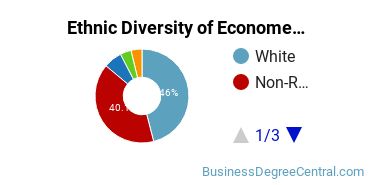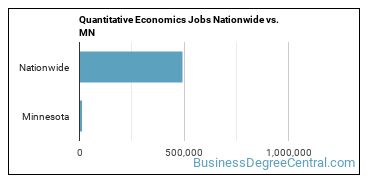Quantitative Economics Schools in Minnesota
292 Econometrics and Quantitative Economics students earned their degrees in the state in 2020-2021.
In this state, Quantitative Economics is the 9th most popular major out of a total 76 majors commonly available.
Featured schools near , edit
Education Levels of Quantitative Economics Majors in Minnesota
Econometrics and Quantitative Economics majors in the state tend to have the following degree levels:
| Education Level | Number of Grads |
|---|---|
| Bachelor’s Degree | 256 |
| Doctor’s Degree (Research / Scholarship) | 28 |
| Doctor’s Degree (Professional Practice) | 28 |
| Doctor’s Degree (Other) | 28 |
| Master’s Degree | 8 |
Gender Distribution
In Minnesota, a econometrics and quantitative economics major is more popular with men than with women.

Racial Distribution
The racial distribution of econometrics and quantitative economics majors in Minnesota is as follows:
- Asian: 5.1%
- Black or African American: 0.7%
- Hispanic or Latino: 2.1%
- White: 36.3%
- Non-Resident Alien: 50.0%
- Other Races: 5.8%

Jobs for Quantitative Economics Grads in Minnesota
In this state, there are 9,900 people employed in jobs related to an econometrics and quantitative economics degree, compared to 494,240 nationwide.

Wages for Quantitative Economics Jobs in Minnesota
A typical salary for a econometrics and quantitative economics grad in the state is $110,060, compared to a typical salary of $116,020 nationwide.

Most Popular Quantitative Economics Programs in MN
There are 6 colleges in Minnesota that offer econometrics and quantitative economics degrees. Learn about the most popular 6 below:
Of all the students who attend this school, 80% get financial aid. The student to faculty ratio is 17 to 1. The student loan default rate is 1.70% which is lower than average.
Students enjoy a student to faculty ratio of 10 to 1. Most students complete their degree in 4.06 years. 83% of the teachers are full time.
The student to faculty ratio is 8 to 1. The student loan default rate is 0.80% which is lower than average. 74% of students are awarded financial aid at this school.
Of all the students who attend this school, 99% get financial aid. 71% of the teachers are full time. In their early career, St. Olaf grads earn an average salary of $43,815.
Seeking financial aid? At this school, 98% of students receive it. 56% of the teachers are full time. The student to faculty ratio is 14 to 1.
93% of students get financical aid. The full-time teacher rate is 65%. Most students complete their degree in 4.61 years.
Quantitative Economics Careers in MN
Some of the careers econometrics and quantitative economics majors go into include:
| Job Title | MN Job Growth | MN Median Salary |
|---|---|---|
| Managers | 7% | $118,410 |
| Economists | 5% | $68,050 |
| Economics Professors | 3% | $95,020 |
Related Majors in Minnesota
Below are some popular majors in the state that are similar to econometrics and quantitative economics.
| Major | Annual Graduates in MN |
|---|---|
| General Economics | 430 |
| Applied Economics | 80 |
| Development Economics | 21 |
| Other Economics | 20 |
| International Economics | 4 |
View all majors related to Quantitative Economics
Explore Major by State
Alabama
Arkansas
Connecticut
Florida
Idaho
Iowa
Louisiana
Massachusetts
Mississippi
Nebraska
New Jersey
North Carolina
Oklahoma
Rhode Island
Tennessee
Vermont
West Virginia
View Nationwide Quantitative Economics Report
References
- College Factual
- National Center for Education Statistics
- O*NET Online
- Image Credit: By pixabay under License
More about our data sources and methodologies.
Featured Schools
You have goals. Southern New Hampshire University can help you get there. Whether you need a bachelor's degree to get into a career or want a master's degree to move up in your current career, SNHU has an online program for you. Find your degree from over 200 online programs.
Visit School






